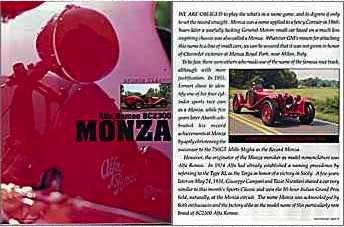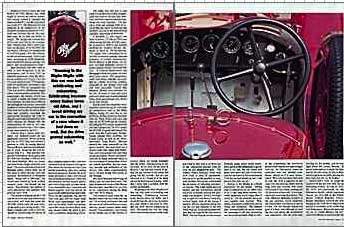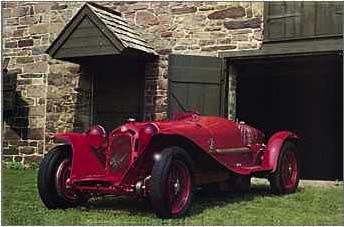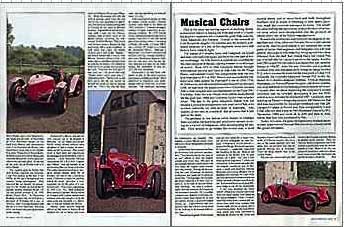about
by Peter Vack
photos by Mary Decker Vack
We are obliged to play the what's in a name game, and to digress if only to set the record straight. Monza was a name applied to a fancy Corvair in 1960. Years later a woefully lacking General Motors small car based on a much less inspiring chassis was also called a Monza. Whatever GM's reason for attaching this name to a line of small cars, we can be assured that it was not given in honor of Chevrolet victories at Monza Royal Park, near Milan, Italy.
To be fair, there were others who made use of the name of the famous race track, although with more justification. In 1955, Ferrari chose to identify one of his four cylinder sports race cars as a Monza, while five years later Abarth celebrated his record achievements at Monza by aptly christening the successor to the 750GT Mille Miglia as the Record Monza.
However, the originator of the Monza moniker as a model nomenclature was Alfa Romeo. In 1924 Alfa had already established a naming precedence by referring to the Type RL as the Targa in honor of a victory in Sicily. A few years later on May 24, 1931, Guiseppe Campari and Tazio Nuvolari shared a car vary similar to this month's Sports Classic and won the 10-hour Italian Grand Prix held, naturally, at the Monza circuit. The name Monza was acknowledged by both enthusiasts and the factory alike as the model name of this particularly rare breed of 8C2300 Alfa Romeo.
Despite its famous victory, the Alfa Romeo 8C2300 Monza was what might be termed an interim model, fate having slotted it between the championship P-2 and the even more successful P-3. The Monzas were not expected to be competitive in the Grand Prix events scheduled for 1931, when the formula had but one rule: that races be at least ten hours in length. The design and construction of the cars were left to the imagination. Vittorio Jano, Alfa's chief engineer and designer of the 8C2300, felt the Monza, with only 150 horsepower in a 850 kilogram (1870 lbs) chassis, would not be fast enough. Even years later, according to Griff Borgeson, Jano recalled the chassis as being "too heavy" and "no masterpiece of mine."
Jano obviously had little faith in what is now recognized to be hi masterpiece, and in early 1931 he obtained permission from the directors to construct a U12 (yes, U12, not V12) car based on two 1750 engines, with two gearboxes, driveshafts, and final drives. The car, designated the Tip A as the first Alfa Romeo single seater, had tremendous potential. But surprisingly, the Monza, which was in reality a sports car turned Grand Prix machine, not only won at Monza but throughout the season, continued to show its heels to the problem-laden Tip A as well as the rest of the field. Jano had probably overrated the competition (primarily the Type 51 Bugatti) and underestimated his own skills because the Monza won the championship for Alfa in 1931 and continued victorious into 1932, when in was superseded by the P-3.
Vittorio Jano's talents were certainly not underestimated by his employers, however. While working for Fiat in 1923, Jano was offered a position at Alfa by racing director Giorgio Rimini, and was immediately put to work designing the Fiat-inspired Alfa P-2. This success was quickly followed by the uniquely Jano 6C1500 (six cylinders, 1500 cc) with five main bearings, alloy wet sump, and detachable single overhead cam head. The valves were machined with threaded stems, which made use of two discs to affect an easy valve adjustment. In addition to, as Borgeson states, "being hell to fabricate,” the valves also tended to break at their weakest point: the threads on the stems. Nonetheless, this method of valve adjustment was standard Alfa practice until 1954.
The double overhead cam 6C1750 was the next variant, also enormously successful, and from that came the 8C2300, which used the same bore, stroke and overall design as the 1750. Eight cylinders and 2336 cc were obtained by constructing two blocks of four cylinders mated with a common valve drive in the center of the engine. The reason for mating two fours was not for economics, since new casting had to be produced. Instead, the technique provided a viable and efficient way to decrease cranshaft vibrations and torsional stresses usually associated with a long eight cylinder block. Two crankshafts were machined and bolted together, with two helical cut gears sandwiched between each crank. Drive for the camshafts was derived from one gear and the single stage Roots type supercharger was operated via the other. Small coil springs, much like those in clutch discs, were also placed within the gears to provide a crankshaft dampening effect.
The crank was laid into a case made of cast aluminum alloy (magnesium was used on the race cars, however) and was a massive unit incorporating ten main bearings. The machine work and castings were so accurate that any one of the bearing caps would fit any one of the main bearing supports, backwards or forwards.
A standard 2.3 liter engine was rated at nearly 135 bhp at 4900 rpm, while racing versions, with the capacity increased to 2600 cc and suitably modified by Scuderia Ferrari, produced as much as 180 horsepower. The engine was a showpiece of incredible aluminum castings, intricate examples of artistic functionality. Bolted directly to the frame, the engine provided increased chassis rigidity, similar to today's Formula One cars. A 4-speed transmission was disengaged from the engine via a dry multi-plate clutch. The suspension, aside from being virtually non-existent as a bump absorbing medium, consisted of leaf springs front and rear with adjustable friction disc dampers. Brakes were excellent for the era. A series of rods and clevis joints activated cams which expanded brake shoes against huge alloy drums on all four wheels.
The 8C2300 was originally introduced as a sports racing car, and made an inauspicious start in the Mille Miglia, losing the race due to tire problems. In may, however, Nuvolari won the Targa Florio and from that time on the 8C2300 and its variants, including the P-3, simply steamrolled over the competition. In 1931 alone, the 8C2300 in sports and Grand Prix guise won the Comminges, Dieppe, Italian Grands Prix, LeMans, the Coppa Ciano, as well as the aforementioned Targa Florio. Monzas utilized the same essentials as the sports models , but were built on a shorter eight feet, eight inch wheel-base, and were graced with very light aluminum bodies. What is incomprehensible to nearly everyone today is not the abilities of the machine, which are indeed incredible, but the stamina, strength and endurance of the drivers who often singlehandedly drove 10-hour Grand Prix events in the Monzas.
We have first hand knowledge of what a feat this must have been. But Gary Schowald, owner of the Monza featured here, described for us a few of his experiences during the three day 1987 Mille Miglia.
"On relatively open roads the car handles better than any other pre-war car. On twisting mountain roads and the streets of medieval Italian towns, steering around corners takes some muscle. The accelerator, like in many of the Italian cars of the thirties, is located where we would normally find the brake. Disconcerting to say the least. As we went off the ramp at Brescia I had horrible visions of hitting the gas instead of the brake and going into the crowds. But as I got adjusted to it I found it to be more natural for heel and toe braking. After that I never had a problem with the central accelerator.
"Running the Mille Miglia with this car was both exhilarating and exhausting. Exhilarating because every Italian loves old Alfas, and I loved driving my car in the recreation of a race where it had done so well. But the drive proved exhausting as well. The second day was very long, more than fourteen hours on the road, and I had to deal with a car fresh out of the restoration process with no time for any shakedown tests. The brakes, which normally work very well, were in need of adjustment, forcing us to use the gearbox to stop, until another Alfa owner unshrouded the mysteries of adjusting mechanical brakes. The water pump gave us trouble and the overheating caused electrical problems because the generator was marginal. Finally, the night run in light rain into Rome, basically without lights, took all the energy I had left. But we remembered that this car has run and finished in the real Mille Miglias. It seemed unconscionable that we might be the only ones to DNF. The fact that the car had always finished, under much worse conditions, gave us the inspiration to go on. And at the end, the old timers and those who knew pre-war Alfas were awed at our stamina. For some reason I felt the car had tested me and I had passed, but only just so."
Riding in the Monza is a brutal experience for the senses. Sitting high--almost on the car rather than in it--the long hood reaches forward, appearing much longer than it really is. The car suddenly becomes very narrow, very pointed. Way ahead, like maybe half a block, are the wings and headlights. The exhaust pipe, without muffler of course, warms the passenger's left arm, reminding one not to let an elbow drop too low. In the windstream, the marvelous noises of the engine and supercharger flow by. All mechanical noises are combined into one metallic symphony, almost as if it were orchestrated. With only two turns from lock to lock, the Alfa is sensitive to any input from the steering wheel, and the long front end twitches with every movement of the wheel, seeking out the direction of the road. It is rough, especially over imperfect tarmac. The only effective springing medium is the seat cushions, which thankfully are comfortable and almost as soft as a sofa. On the straight Schonwald gave it a boot, and although he kept the revs well down, the acceleration was impressive. His feet were busy dancing on the pedals, and he was right about the central throttle. it seems more natural to angle the right foot to the left, using the toe to keep the revs up between shifts, placing the heel more heavily on the brakes.
Schonwald's Alfa, as might be expected of any pre-war Alfa, has an interesting history. In June of 1933, the Alfa was purchased by the Balestrero family, which registered chassis no. 2311206 at the Public Motor Vehicle Registry Office. Renato Balestrero entered the new Monza in the 1934 Mille Miglia and placed a creditable sixth co-driving with Sanguinetti. Balestrero later sold the car to Uboldi Martini, but borrowed the Monza in April to enter the Mille Miglia, again with Sanguinetti, and again placed sixth. In December of 1935, Balestrero bought the car back from Martini and immediately sold it to Giovanni de Rham, who transferred ownership to his brother Giacomo. Teamed with Sergio Banti, de Rahm entered the Mille Miglia and followed Balestrero's sixth place finished with a seventh place. AT the end of the year, the de Rhams sold it to Elda Ermini.
The registry goes no further, but Alfa Romeo engineer and historian Luigi Fusi picked up the trail in the 1970s, as the car's background was initially being investigated. Fusi believed the car became the possession of a Mr. Studer, an Alfa dealer in Zurich. Emilio Romano bought the car and placed seventh in the Berne Grand Prix. In December Romano shipped the car to Eritrea, a province of Ethiopia, for a race at Asmara. After winning, Romano sold the car to a local salesman. Not long after, war broke out, putting an end to motor racing.
Schonwald's Monza was not the only unusual car to be shipped to Ethiopia. As the Allies moved into North Africa, British officers were delighted to find a variety of delectable cars left by Italians. They would write of their finds and experiences for the pages of an information-starved Autocar. "Axis Machines Provide Amusement for R.E.M.E. Captain and Others." was the subtitle of an article about the cars found in Eritrea. The author had purchased an ex-Scuderia Ferrari Monza there for 40 Pounds, but had to pay a mechanic some 15 Pounds to repair the pistons, which he stated "provided a thoroughbred car for the price of a new motorcycle." Even more interesting, in 1942, a Lt. N.L. Hall submitted three photos of another Monza found in Asmara with a more streamlined radiator cowl, and thought it to be the same as the one owned by a Lt. Mardsen. It was the Schonwald Monza.
Shortly after, another English officer by the name of Jimmy Braid shipped the car to India, and there sold it to Maharaja Myrasingh of Ranchi. What Myrasingh did with the Alfa is unclear, aside from the fact that he was very attached to it, and finally let it go to an American engineer in Calcutta by the name of Howard Jackson. A good driver and an enthusiast with a keen eye for classics, Jackson came to know many of the Indian princes, including one who owned 136 Rolls-Royces. This prince told Jackson about a Bugatti he had purchased, still in good condition. It took about four years, but finally Jackson got a look at the "Bugatti," and found instead that it was an Alfa Monza. Jackson offered a Fiat 1100 sedan and a Lambretta motor scooter in trade for the Monza. The Maharaja went out to the garage and started up the Alfa. "You take the Alfa and I'll take your car," the prince had said. "Money didn't really enter into it," Jackson recalled. "I believe he would have given me the car except he thought he saved me face by trading with me. That's the way the Rajs were. Selling something was beneath them, in a way."
After successfully racing the Alfa in various events around Calcutta, Jackson came back to the States in 1963, and sold it. It passed through a number of hands, essentially in non-running condition. By 1979, current owner Schonwald had accumulated a sizable collection of cars, and traded part of his existing stable--including a Ferrari 166 coupe, a Cooper Mk I, and a Ferrari 195 coupe--to obtain the unrestored Monza. Although a basket case, it still had the streamlined radiator cowling, making identification easier. Restoration began in 1986, and one year later, only one day before shipping it to Italy for the Mille Miglia, the restoration of Alfa no. 2311206 was completed.
Schonwald's car had been subjected to one of the most rigorous restorations available anywhere. Strict adherence to originality was maintained, with no cotter key of washer immune. The essentials, including the instruments, are original. The fenders, a typical Monza option, were fabricated from old patterns obtained in England.
Schonwald views restoration from an economic and practical perspective. "You have to realize that most of us can't afford to have the engine rebuilt after every race. We have to incorporate rational modifications that will make the engine more reliable and long lasting. During the restoration we took advantage of modern techniques and materials to promote reliability. The bearings, for example, are either replaced with shell type inserts or, in the case of poured babbitt-type bearings, we used a sophisticated bearing material developed by the aerospace industry. Oil is another compromise. Instead of running a romantic castor bean-based oil, as nice as it smells, we use 12 quarts of modern racing oil. Castor-based oils will quickly turn into a heavy syrup when let sit, so it has to be drained after every use.
"I found the original 19 inch wheel size not only made for a rough ride, but proved inadequate on tight circuits. Changing to 18 inch wheels--made after Rudge Whitworth patterns in England--materially improved the handling of the car. Monzas did compete in the thirties with 18 inch wheels, so I didn't feel that I was straying from originality." After a bit of research, Schonwald concluded that the original coachwork was by Brianza, a small and relatively obscure Milanese carrozzeria. Brianza was in business only between 1932 and 1938, and was said to have constructed sports bodies for both Alfa and Isotta Fraschini. Schowald found an original Brianza badge to top off the restoration.
It was once assumed that about 200 8C2300s of all chassis types were built, but those figures were based on the engine numbers. Today, it is reckoned that fewer were constructed, because there were more engines than chassis built, for use as spares and to power racing boats. Some long wheel-base sports cars were converted to Monzas by owners in the 1930s and Scuderia Ferrari built Monzas as well as the Alfa Romeo factory. No one is sure of the actual numbers built, but today there are probably less than 20 genuine Monzas still in existence. There are three, maybe four, in the United States.
Pre-war cars, particularly pre-war classics like Bugatti and Alfa, belong to another genre entirely. They are visceral, brutal, engineered and hand crafted to perfection with no consideration of cost. Most of all, they are pieces of machinery, and every detail, every noise, every line highlights this period of man's creativity.

Sports Car Illustrated
January 1989




Sports Classic:
Alfa Romeo 8C2300 Monza
Press
